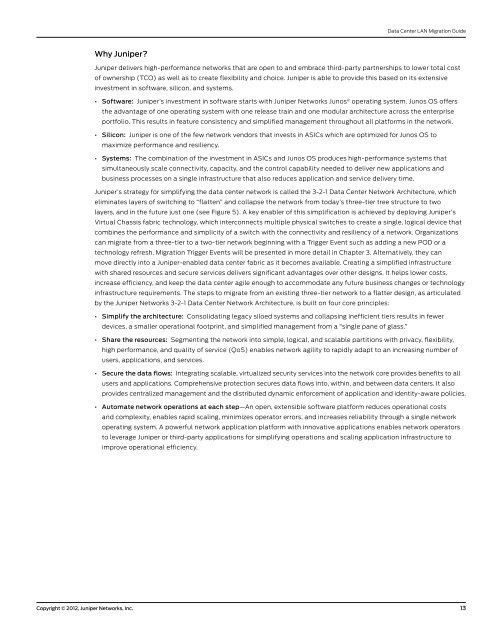Data Center LAN Migration Guide - Juniper Networks
Data Center LAN Migration Guide - Juniper Networks
Data Center LAN Migration Guide - Juniper Networks
Create successful ePaper yourself
Turn your PDF publications into a flip-book with our unique Google optimized e-Paper software.
Why <strong>Juniper</strong>?<br />
<strong>Data</strong> <strong>Center</strong> <strong>LAN</strong> <strong>Migration</strong> <strong>Guide</strong><br />
<strong>Juniper</strong> delivers high-performance networks that are open to and embrace third-party partnerships to lower total cost<br />
of ownership (TCO) as well as to create flexibility and choice. <strong>Juniper</strong> is able to provide this based on its extensive<br />
investment in software, silicon, and systems.<br />
• Software: <strong>Juniper</strong>’s investment in software starts with <strong>Juniper</strong> <strong>Networks</strong> Junos ® operating system. Junos OS offers<br />
the advantage of one operating system with one release train and one modular architecture across the enterprise<br />
portfolio. This results in feature consistency and simplified management throughout all platforms in the network.<br />
• Silicon: <strong>Juniper</strong> is one of the few network vendors that invests in ASICs which are optimized for Junos OS to<br />
maximize performance and resiliency.<br />
• Systems: The combination of the investment in ASICs and Junos OS produces high-performance systems that<br />
simultaneously scale connectivity, capacity, and the control capability needed to deliver new applications and<br />
business processes on a single infrastructure that also reduces application and service delivery time.<br />
<strong>Juniper</strong>’s strategy for simplifying the data center network is called the 3-2-1 <strong>Data</strong> <strong>Center</strong> Network Architecture, which<br />
eliminates layers of switching to “flatten” and collapse the network from today’s three-tier tree structure to two<br />
layers, and in the future just one (see Figure 5). A key enabler of this simplification is achieved by deploying <strong>Juniper</strong>’s<br />
Virtual Chassis fabric technology, which interconnects multiple physical switches to create a single, logical device that<br />
combines the performance and simplicity of a switch with the connectivity and resiliency of a network. Organizations<br />
can migrate from a three-tier to a two-tier network beginning with a Trigger Event such as adding a new POD or a<br />
technology refresh. <strong>Migration</strong> Trigger Events will be presented in more detail in Chapter 3. Alternatively, they can<br />
move directly into a <strong>Juniper</strong>-enabled data center fabric as it becomes available. Creating a simplified infrastructure<br />
with shared resources and secure services delivers significant advantages over other designs. It helps lower costs,<br />
increase efficiency, and keep the data center agile enough to accommodate any future business changes or technology<br />
infrastructure requirements. The steps to migrate from an existing three-tier network to a flatter design, as articulated<br />
by the <strong>Juniper</strong> <strong>Networks</strong> 3-2-1 <strong>Data</strong> <strong>Center</strong> Network Architecture, is built on four core principles:<br />
• Simplify the architecture: Consolidating legacy siloed systems and collapsing inefficient tiers results in fewer<br />
devices, a smaller operational footprint, and simplified management from a “single pane of glass.”<br />
• Share the resources: Segmenting the network into simple, logical, and scalable partitions with privacy, flexibility,<br />
high performance, and quality of service (QoS) enables network agility to rapidly adapt to an increasing number of<br />
users, applications, and services.<br />
• Secure the data flows: Integrating scalable, virtualized security services into the network core provides benefits to all<br />
users and applications. Comprehensive protection secures data flows into, within, and between data centers. It also<br />
provides centralized management and the distributed dynamic enforcement of application and identity-aware policies.<br />
• Automate network operations at each step—An open, extensible software platform reduces operational costs<br />
and complexity, enables rapid scaling, minimizes operator errors, and increases reliability through a single network<br />
operating system. A powerful network application platform with innovative applications enables network operators<br />
to leverage <strong>Juniper</strong> or third-party applications for simplifying operations and scaling application infrastructure to<br />
improve operational efficiency.<br />
Copyright © 2012, <strong>Juniper</strong> <strong>Networks</strong>, Inc. 13

















